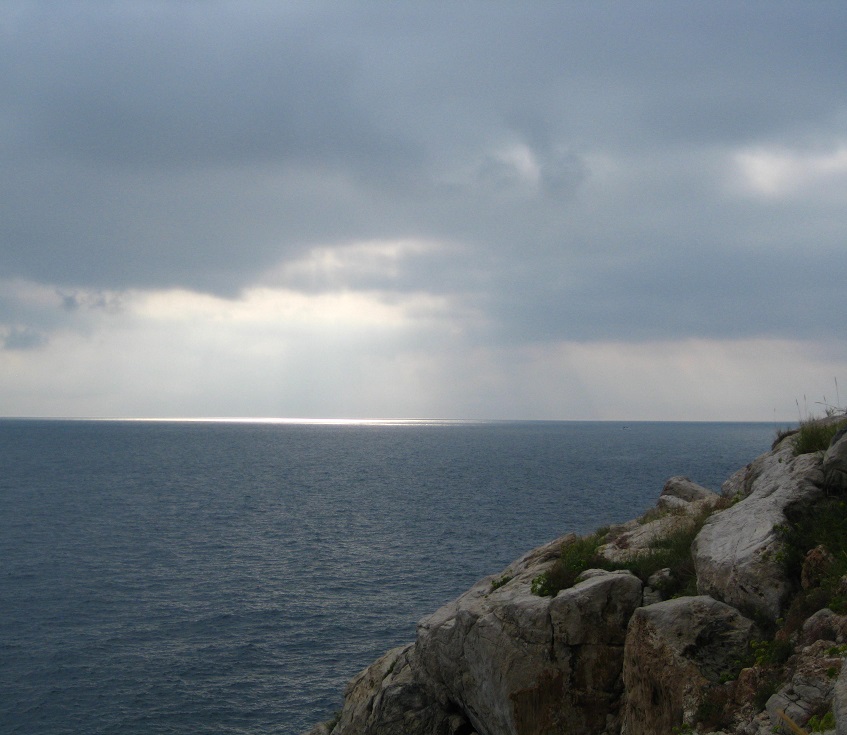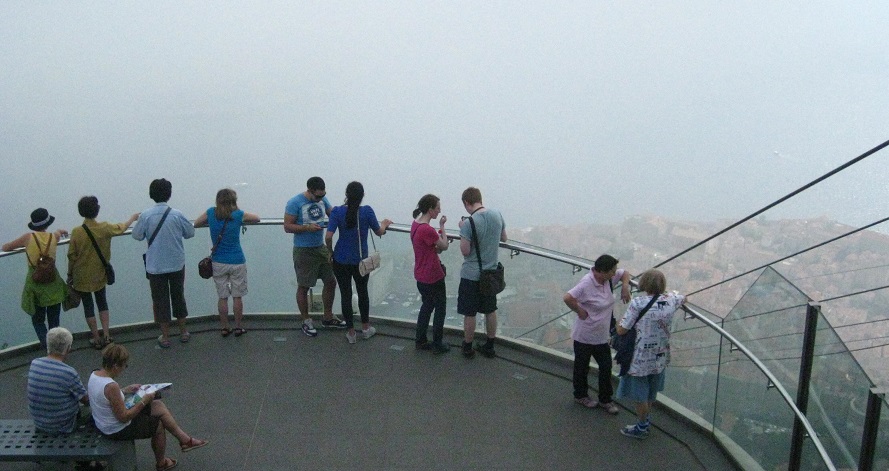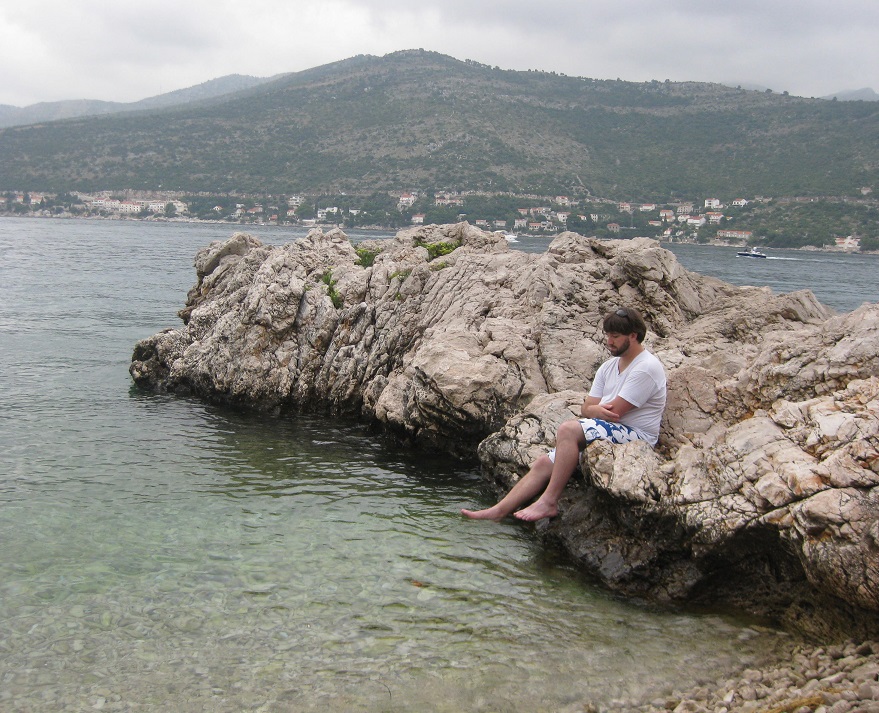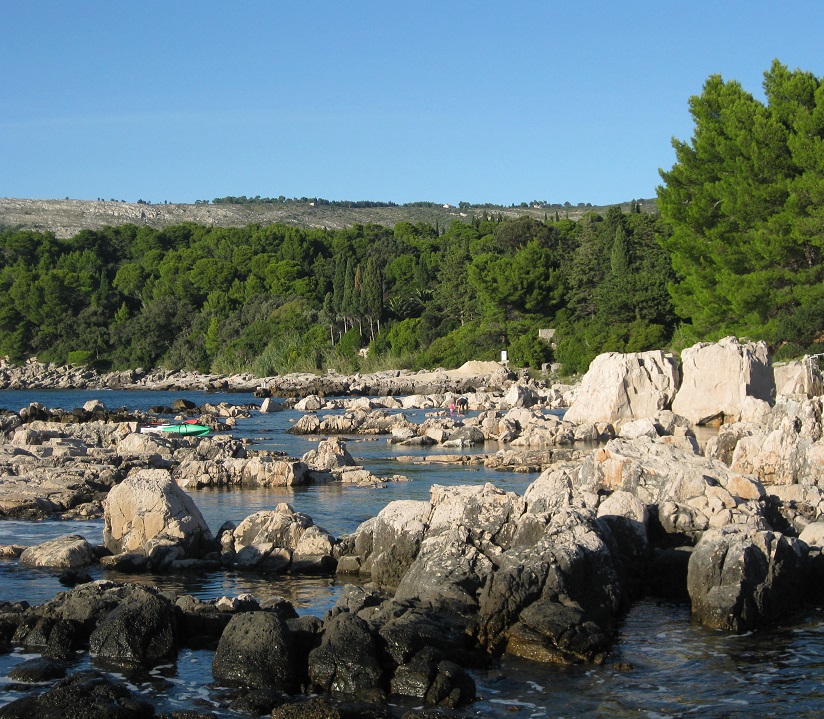We were in Dubrovnik for 3.5 days.
- Old Town Walls: I was skeptical of this activity, because paying $20 each to walk up and down steps with lots of other tourists seemed silly. However, everyone seems to recommend it, so we did it. And it was probably worth it. Imagine a big fortress surrounding a town right on the water, with these walls’ walkways elevated above the town.
 Along the way, there are sentry points and even little holes from which to shoot arrows out. It turns out that the entire point of the walls was not so much to keep an enemy away, but to keep the sea water at bay: most of the town’s houses were built of a kind of wood that would be easily destroyed by salt water. I’m not really sure what the sentries could have done if they saw a tsunami coming, but presumably there was a reason for the lookouts. Either way, the 1-3 hour walk – depending on how many photos you take or how many ice creams you stop to eat – is nice. The breeze is perfect on hot days, the views of the water and town are gorgeous, and you can laugh at all the tourists taking exactly the same photos – or eavesdrop on their French/English/German/Russian. Also, from up there, you can see the ‘world’s coolest basketball court,’ according to B.
Along the way, there are sentry points and even little holes from which to shoot arrows out. It turns out that the entire point of the walls was not so much to keep an enemy away, but to keep the sea water at bay: most of the town’s houses were built of a kind of wood that would be easily destroyed by salt water. I’m not really sure what the sentries could have done if they saw a tsunami coming, but presumably there was a reason for the lookouts. Either way, the 1-3 hour walk – depending on how many photos you take or how many ice creams you stop to eat – is nice. The breeze is perfect on hot days, the views of the water and town are gorgeous, and you can laugh at all the tourists taking exactly the same photos – or eavesdrop on their French/English/German/Russian. Also, from up there, you can see the ‘world’s coolest basketball court,’ according to B. - Old Town: The town itself is small, with narrow winding streets, filled with tourists and tourist traps. Certainly, there were cute painted glasses, relatively unique jewelry, and ‘local’ knick-knack souvenirs. But there were also restaurants with lunch dishes for $30, so we tried to stick to ice cream there. Farther on the outskirts (this is not a large town), there were empty little streets, which were cuter. We ambled past a small music school, a few different kinds of churches, and people’s apartments, with laundry hanging out on the line.
- Cafe Buza: This
 cafe is right on the water in the Old Town, facing Lokrum Island. It has wonderful views of the water and the sunset, and some people are even said to cliff jump from here. The water wasn’t too warm that day, and – to me – it looked like you’d have to jump very far out to stay clear of the rock on the way down. But, you can also just sit on the rocks there without getting anything to drink, which is a pretty good idea given that a basic beer was $8+.
cafe is right on the water in the Old Town, facing Lokrum Island. It has wonderful views of the water and the sunset, and some people are even said to cliff jump from here. The water wasn’t too warm that day, and – to me – it looked like you’d have to jump very far out to stay clear of the rock on the way down. But, you can also just sit on the rocks there without getting anything to drink, which is a pretty good idea given that a basic beer was $8+. - St. Stepan’s Church: This church had a slightly unusual little grotto dedicated to Mary: I’ve only seen one other like it, in Turin. It looked like dripping white stones, like the Sagrada Familia, and it was behind a little black iron gate. There were also some stained glass windows, altars, etc. Cute, but not a must-do.
- Mount Srđ Cable Car: It’s a fun cable
 car (unless you’re afraid of heights), but it’s not very adrenaline-inducing. I liked looking out from the front as we went up, so I could watch as we seemed to become part of the the blanket of incredibly-green firs. And the top has a number of different viewing platforms, which must look even more wonderful on days which are not so foggy. Fun experience, but it’s not super cheap, so if you’ve been on a cable car before, you can skip it. If not, go.
car (unless you’re afraid of heights), but it’s not very adrenaline-inducing. I liked looking out from the front as we went up, so I could watch as we seemed to become part of the the blanket of incredibly-green firs. And the top has a number of different viewing platforms, which must look even more wonderful on days which are not so foggy. Fun experience, but it’s not super cheap, so if you’ve been on a cable car before, you can skip it. If not, go. - Imperial Fort/War of Aggression Museum: This museum documents the Croatian’s heroic fight during what they call ‘The War of Serbian and Montenegran Aggression’ or the ‘Homeland War.’ The basic idea is that Croatia left Yugoslavia in 1991, but the Serbs especially did not like this, because there was a decently-sized minority of them living in Croatia, and because they wanted to create a ‘Greater Serbia.’ So, they started to both destroy Croatia’s land and conquer its people. During this war, much of Dubrovnik – already a UNESCO-recognized historical site of some significance – was largely destroyed.
 The description of the Croatian side was actually alarmingly laughable: first, no one thought there was going to be fighting, then they started doing some basic prep and were able to cobble together 100 soldiers and a dozen or so weapons, and so on. Eventually, this ridiculously small core of fighters hunkered down in this Imperial Fort (originally built by Bonaporte, long before) and managed to hold off the Serbian fighters for a long time. Talk about an underdog story: this was a basketball team-sized group of men battling it out against an army. The Cliff’s Notes version: the Croatian men retained control of the fort, the international community largely ignored the war, 20% of Croatia and even more of historic Dubrovnik was destroyed, and all of life was turned upside down (from 5M to 500K tourists does a number on your economy). It sounded like the north of the country worked with international forces to help broker peace, but the Dubrovnik/southern men were allowed to pretty much get rid of the invaders on their own. It resulted in more deaths, but fewer regulations in re-establishing peace. The borders returned to their pre-war boundaries, and Croatia still feels that the world ignored their defensive (not offfensive) struggle. The fort itself is fairly run down, and a number of the exhibits are in Croatian only, but I think some war museum is worth going to, to try to understand this little-known war. (Maybe it is more familiar to those of you teen-aged or older in 1991, but I was a tad distracted at the time.)
The description of the Croatian side was actually alarmingly laughable: first, no one thought there was going to be fighting, then they started doing some basic prep and were able to cobble together 100 soldiers and a dozen or so weapons, and so on. Eventually, this ridiculously small core of fighters hunkered down in this Imperial Fort (originally built by Bonaporte, long before) and managed to hold off the Serbian fighters for a long time. Talk about an underdog story: this was a basketball team-sized group of men battling it out against an army. The Cliff’s Notes version: the Croatian men retained control of the fort, the international community largely ignored the war, 20% of Croatia and even more of historic Dubrovnik was destroyed, and all of life was turned upside down (from 5M to 500K tourists does a number on your economy). It sounded like the north of the country worked with international forces to help broker peace, but the Dubrovnik/southern men were allowed to pretty much get rid of the invaders on their own. It resulted in more deaths, but fewer regulations in re-establishing peace. The borders returned to their pre-war boundaries, and Croatia still feels that the world ignored their defensive (not offfensive) struggle. The fort itself is fairly run down, and a number of the exhibits are in Croatian only, but I think some war museum is worth going to, to try to understand this little-known war. (Maybe it is more familiar to those of you teen-aged or older in 1991, but I was a tad distracted at the time.) - Lapad Beaches: Beaches is a misnomer:
 they’re pebbles along the water. Not fun to walk on barefoot at all, but so many beaches that you’re bound to find some space just to yourself. And the water is quite warm and the view is beautiful, so worth visiting – as long as you don’t expect white sand.
they’re pebbles along the water. Not fun to walk on barefoot at all, but so many beaches that you’re bound to find some space just to yourself. And the water is quite warm and the view is beautiful, so worth visiting – as long as you don’t expect white sand. - Lokrum Island: This is likely the best thing we did in town.
 We rented a two-person kayak, and we paddled from the Old Town to Lokrum Island, around it, and back along the city walls. The Island had some isolated spots where we were able to beach the kayak (on purpose), to have a snack, a swim, and a climb. It was all rocky outcroppings, not beach, but so sparsely populated with other tourists and beautiful on a sunny day that it was very relaxing. They say that there is a nude beach here, primarily populated by wrinkled Germans, but we didn’t see any of them. We also didn’t get to see the official Botanical Garden here, though we saw lots of trees and nature all around us. Definitely worth it, though not exactly sure if it was the Island specifically or more the kayaking. [It’s green in this photo.]
We rented a two-person kayak, and we paddled from the Old Town to Lokrum Island, around it, and back along the city walls. The Island had some isolated spots where we were able to beach the kayak (on purpose), to have a snack, a swim, and a climb. It was all rocky outcroppings, not beach, but so sparsely populated with other tourists and beautiful on a sunny day that it was very relaxing. They say that there is a nude beach here, primarily populated by wrinkled Germans, but we didn’t see any of them. We also didn’t get to see the official Botanical Garden here, though we saw lots of trees and nature all around us. Definitely worth it, though not exactly sure if it was the Island specifically or more the kayaking. [It’s green in this photo.]
What We Skipped:
- Lindo Folk Dancing: The description on this site is worth reading through, because it claims that the people who do this sort of dancing are pretty much just the cool kids; no outcasts or shy people allowed. It seemed like a tourist attraction, so we passed on it.
- War Photo Limited: I particularly wanted to visit this photography museum because I think photos tell stories well, but we just didn’t have time, unfortunately.
- Dominican Monastery: Not sure if this was one of the many churches in the town, but the guide I read said it had stained glass and carvings. Maybe next time.
- Franciscan Monastery: They say that this monastery has the 3rd oldest pharmacy in the world, but we didn’t see it anywhere. Of course, we didn’t spend a lot of time looking.
- Bukovac House: We passed by this painting gallery, which seemed to just have a few things in there by one guy; seemed expensive for what it was.
- Maritime Museum: This was expensive for what it seemed to be.
- Ethnographic Museum: Just wasn’t a big priority for us, though we passed by it.



Pingback: What We Saw on Railay Beach - Novelty Buffs